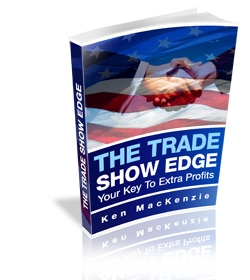
How to lead a prospective trade show booth visitor to
the decisive act of placing an order.
Trade shows are a great opportunity for businesses to connect with potential customers and clients. One of the most important aspects of a successful trade show experience is the ability to effectively listen to and engage with visitors at your booth.
By actively listening to their needs and concerns, you can build trust and establish valuable connections. In this guide, we will discuss the best practices for listening to trade booth visitors and making the most of your time at the event.
The decision-making process
By participating in a trade show booth you lead a prospect from showing mild curiosity to the decisive act of placing an order. Trade shows are a great opportunity for businesses to connect with potential customers and clients. One of the most important aspects of a successful trade show experience is the ability to effectively listen to and engage with visitors at your booth. By actively listening to their needs and concerns, you can build trust and establish valuable connections. In this guide, we will discuss the best practices for listening to trade booth visitors and making the most of your time at the event of placing an order.

In fact, the trade show makes an important contribution to the shortening of the decision-making process.
At a trade show, you have a high proportion of prospects, because the audience is pre-selected.
When a visitor walks into your trade show booth it means he or she has some interest in what you are exhibiting.
The trade show booth visitor wants some kind of information. Therefore, you have an opportunity to direct the conversation to your product(s) or services.
By being in your trade show booth the prospect is ready to speak to the salesman and even if he or she hasn’t heard of your company or your products they have an enquiring mind.
Remember – you must give your trade show booth visitor your full attention.
Do not be distracted by something going on across the trade show floor which catches your eye, or being interrupted by your mobile phone ringing in the trade show booth, or reading a piece of paper while your customer is talking to you. Keep good eye contact and use active listening.
By focusing only on your visitor you convey the message that you are available, willing, and able to help. You are devoting your full resources to him or her alone.
That starts to give him faith in your abilities and a feeling of ‘I’ve come to the right trade show booth’.
Listen attentively and listen actively to your trade show booth visitor.
Turn your attention to the other person: “What are your needs?” “How can I help you?” Then listen. Always pivot the conversation around the other person.
Listening attentively allows you to make a valid and sensible response to your visitor’s statement or question.
Listening actively goes one step further. It shows your trade show booth visitor that you are sincerely interested in being of assistance in the best way that you can.
It involves the skills of clarifying and confirming your understanding of what he or she says to you.
You can use clarifying questions to get more information about the subject or problem.
Confirming questions to check that you do indeed know what he or she is talking about.
Clarifying questions tend to be a more open type of question such as, “So what effect does that have on your…?” or “Can you explain a bit more about…?” or
“How will that influence…?”
You are seeking a deeper understanding of the problem or issue so you can give a more accurate diagnosis or recommendation as to how you will solve it for him.
Confirming questions tend to be more closed when you are looking to show your trade show booth visitor that you fully understand the issue or problem.
A question such as, “So your problem is …, have I got that right?” would show that you not only understood but you can articulate it back to him in your own words.
Good listening techniques
Some good listening techniques include nodding; smiling; making eye contact; showing signs of interest and encouraging such as leaning toward the speaker.
In addition, asking questions; repeating keywords back; not interrupting; not looking bored; and making listening noises such as “Aha”, “Yes”, and “Mmm”.
Why is attentive and active listening so important? Because every trade show booth visitor is different with different needs, and until you know exactly what those individual needs are, you could only offer a ‘one size fits all’ solution. That can never work effectively.
In conclusion, effective listening is a crucial aspect of a successful trade show experience. By actively engaging with visitors at your booth and taking the time to truly understand their needs, you can build trust and establish valuable connections.
Remember to be present in the conversation, avoid interrupting, and ask open-ended questions. By following these best practices, you can make the most of your time at the trade show and come away with valuable leads and connections.
Don’t forget to follow up with them after the trade show, it will help you to strengthen the relationship.
Pre Trade Show Marketing is Critical | Ideas for Success
As an Amazon Affiliate, I earn from qualifying purchases. TheTradeShowEdge.com is a participant in the Amazon Services LLC Associates Program, an affiliate advertising program designed to provide a means for sites to earn advertising fees by advertising and linking to Amazon.com.
Links on this trade show booth visitor page are sponsored affiliate links and the owner makes a commission if you buy after clicking these links. The owner is not a bonafide trade show booth visitor. However, he has thoroughly researched it and provided a personal opinion only. This disclosure is in accordance with the Federal Trade Commission’s 16 CFR, Part 255: “Guides Concerning the Use of Endorsements and Testimonials in Advertising.”

